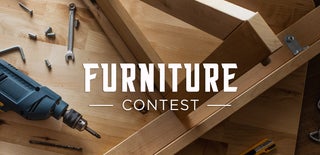Introduction: My Tetris Bookshelf
Back again, yet with another project to challenge my skills.... Welding Metal!!! Pam pam pam!!!
So after a while I looked for something that is missing in our home, I decided to get rid of an ikea bookshelf and to custom built my own...
Hope you will enjoy this intractable...
Supplies
36m Metal 10mmX10mm
6.2m Mahogany wood - 2cm wide
Metal Geer:
- welding machine
Wood Geer:
- router
Step 1: Design
I started my design from getting a bit of inspiration on pinterest, after i had something in my mind i did some notebook sketches till i had my final design.
The next step of my design was to create a 3D model.
I found many errors from the 3D model, that if i found later it would cost either time or money to correct, the more complicated the design is the more important is to get down to the detail design (one example was in the notebook i didn't thought of the material width... etc')
Attachments
Step 2: Cube Frame
In this step i created a the cube frame of almost whole rectangle, only with the 5cm legs.
The dimensions of frame are 76cm X 195cm (outer measurements).
I started with two rectangles and joint them with four 28cm rods (to end up with 30cm depth).
Important to verify during the whole process that the cube frame is aligned and there are no mistakes...
One that i came into was on one of the corners i welded the wrong rod on top of the other, which caused the width to be 75cm (instead of 76cm), in this step such mistake can make this error roll and none of the rest of the welding work will fit.... VERIFY!!!
Step 3: Inner Frame
After the frame was assembled the majority of the welding work starts, due to the "Tetris" design i choose...
I decided to start from the bottom and weld my way up, i was not sure about the weight of the frame so i thought it will be better that way.
Somewhere after the first two shapes in the tetris i found that i is easier to weld it by modules, and by that i mean to take up to three pieces, weld them together according to the design measurements and by that it was easy to level and keep the welding work more accurate.
Important to state that in this step accuracy is the name of the game....
One thing i did different from the original design was to use a lot less connectors between both of the sides, for two reasons, one was the weight which i wanted to keep it as much lighter as i can, the other reason was i saw that the structure is strong enough...
Once all the shapes were welded, i reinforced each joint to have two welding points. That left me with whole bunch of grinding....
Step 4: Wood
Choosing wood was not an easy task, the candidates were: oak, walnut and mahogany and mahogany was the winner for its color and durability, but also because the walnut (which was my first favorite) was too narrow at the wood warehouse i visited, and i didn't want to glue two boards as per costs and effort...
After choosing mahogany, i planed the two boards i bought and cut the shelves by the measurements (see step 2).
The next step was to curve the edges for the metal frame to fit...
Step 5: Shelves Fine Tuning
Since i removed from the wooden shelves a horizontal niche for the metal frame, i was left with cutting the vertical niches and to compensate for any miss accuracy left from the welding step.
to avoid frustration to locate the shelves place later, i decided to number each "floor" from top to bottom and to assign each shelf his floor number.
The actual work required me a hand saw, a chisel and a wood router (to create the niche on the Z axle). with a measurement tape a marked the vertical place to cut and used the hand saw and a chisel. with the router i removed the 1cm square for the metal frame niche.
Step 6: Sanding Painting Etc'
After all the alignments, its was time for the wrap ups...
Wood-wise it meant sanding with P100 and P320 sand paper and to paint the red wood with transparent varnish.
Metal-wise it meant only painting the metal with black paint.
Step 7: Done
Hope you enjoyed the read!
Thanks for staying this far!
Y.

Second Prize in the
Furniture Contest














